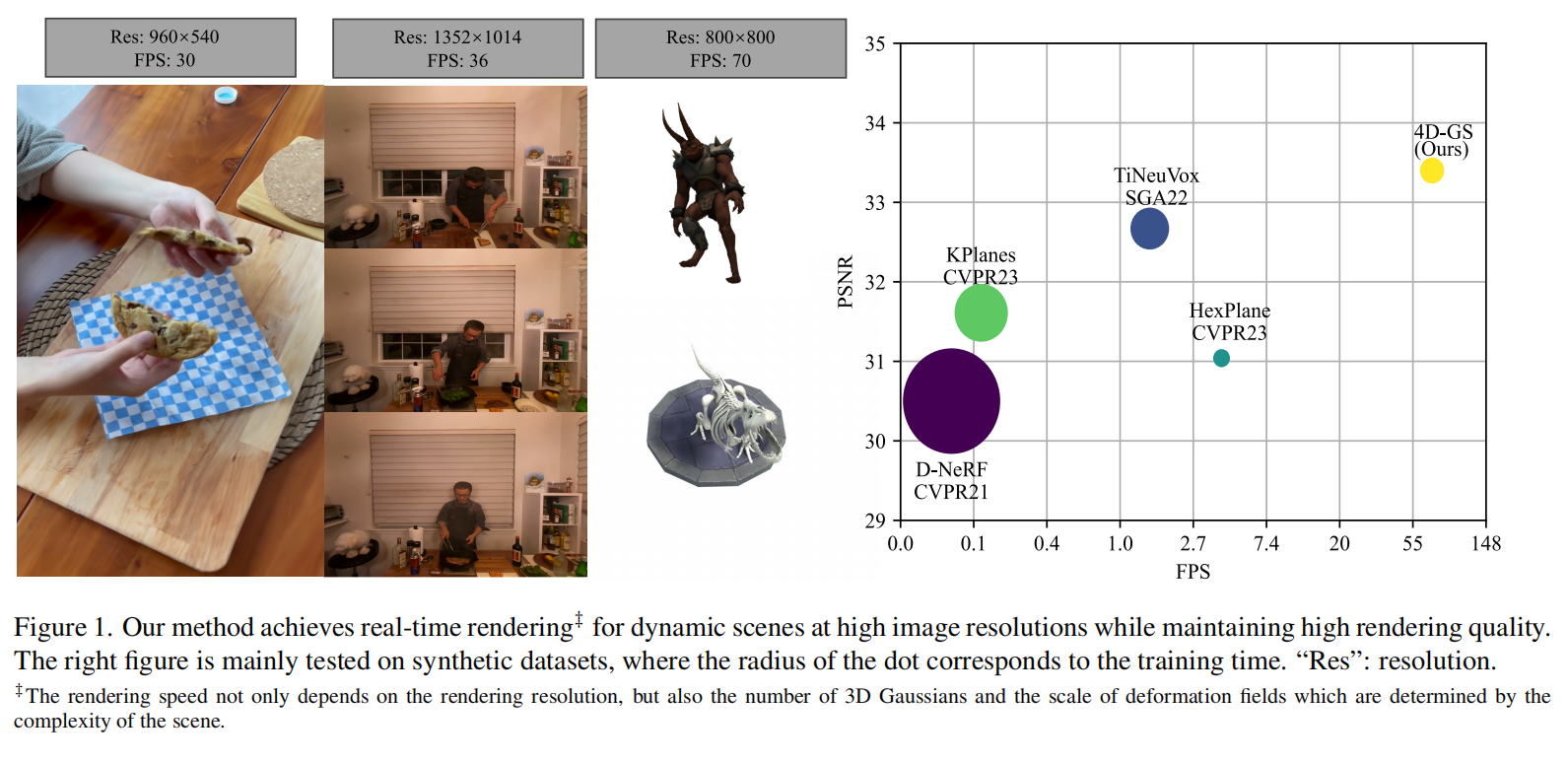Guanjun Wu1*, Taoran Yi2*,
Jiemin Fang3‡, Lingxi Xie3,
Xiaopeng Zhang3, Wei Wei1,Wenyu Liu2, Qi Tian3 , Xinggang Wang2‡✉
1School of CS, HUST 2School of EIC, HUST 3Huawei Inc.
* Equal Contributions.

Our method converges very quickly and achieves real-time rendering speed.
Colab demo: (Thanks camenduru.)
Please follow the 3D-GS to install the relative packages.
git clone https://github.com/hustvl/4DGaussians
cd 4DGaussians
git submodule update --init --recursive
conda create -n Gaussians4D python=3.7
conda activate Gaussians4D
pip install -r requirements.txt
pip install -e submodules/depth-diff-gaussian-rasterization
pip install -e submodules/simple-knnIn our environment, we use pytorch=1.13.1+cu116.
For synthetic scenes:
The dataset provided in D-NeRF is used. You can download the dataset from dropbox.
For real dynamic scenes:
The dataset provided in HyperNeRF is used. You can download scenes from Hypernerf Dataset and organize them as Nerfies. Meanwhile, Plenoptic Dataset could be downloaded from their official websites. To save the memory, you should extract the frames of each video and then organize your dataset as follows.
├── data
│ | dnerf
│ ├── mutant
│ ├── standup
│ ├── ...
│ | hypernerf
│ ├── interp
│ ├── misc
│ ├── virg
│ | dynerf
│ ├── cook_spinach
│ ├── cam00
│ ├── images
│ ├── 0000.png
│ ├── 0001.png
│ ├── 0002.png
│ ├── ...
│ ├── cam01
│ ├── images
│ ├── 0000.png
│ ├── 0001.png
│ ├── ...
│ ├── cut_roasted_beef
| ├── ...
For training synthetic scenes such as bouncingballs, run
python train.py -s data/dnerf/bouncingballs --port 6017 --expname "dnerf/bouncingballs" --configs arguments/dnerf/bouncingballs.py
You can customize your training config through the config files.
Run the following script to render the images.
python render.py --model_path "output/dnerf/bouncingballs/" --skip_train --configs arguments/dnerf/bouncingballs.py &
You can just run the following script to evaluate the model.
python metrics.py --model_path "output/dnerf/bouncingballs/"
There are some helpful scripts in scripts/, please feel free to use them.
This project is still under development. Please feel free to raise issues or submit pull requests to contribute to our codebase.
Some source code of ours is borrowed from 3DGS, k-planes,HexPlane, TiNeuVox. We sincerely appreciate the excellent works of these authors.
We would like to express our sincere gratitude to @zhouzhenghong-gt for his revisions to our code and discussions on the content of our paper.
Some insights about neural voxel grids and dynamic scenes reconstruction originate from TiNeuVox. If you find this repository/work helpful in your research, welcome to cite these papers and give a ⭐.
@article{wu20234dgaussians,
title={4D Gaussian Splatting for Real-Time Dynamic Scene Rendering},
author={Wu, Guanjun and Yi, Taoran and Fang, Jiemin and Xie, Lingxi and Zhang, Xiaopeng and Wei Wei and Liu, Wenyu and Tian, Qi and Wang Xinggang},
journal={arXiv preprint arXiv:2310.08528},
year={2023}
}
@inproceedings{TiNeuVox,
author = {Fang, Jiemin and Yi, Taoran and Wang, Xinggang and Xie, Lingxi and Zhang, Xiaopeng and Liu, Wenyu and Nie\ss{}ner, Matthias and Tian, Qi},
title = {Fast Dynamic Radiance Fields with Time-Aware Neural Voxels},
year = {2022},
booktitle = {SIGGRAPH Asia 2022 Conference Papers}
}